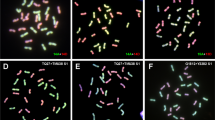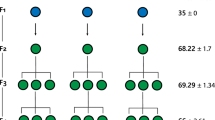Abstract
The patterns of homologue segregation are the basis for euploidy or aneuploidy formation in diploids and allo-/auto-polyploids. Homologue segregation in diploids resembles that in allopolyploids during meiosis; however, meiotic chromosome behavior in autopolyploids is complicated by multiplication of homologous chromosome components. Obviously, loss of single chromosomes (or segmented chromosomes) frequently leads to abortion of reproductive gametes in diploids and allopolyploids. In contrast, the consequence of chromosome loss in autopolyploids is effortlessly compensated for by the presence of multiplied chromosome complements. Here, we use the meiotically asynaptic gene asy1, in combination with polyploidization, to elucidate aneuploidy formation in autotetraploid Arabidopsis. The results indicate that, due to homologous asynapsis in meiotic prophase I, retarded chromosome losses could induce aneuploidy during gametogenesis in autotetraploid asy1. The severe loss of individual chromosomes probably reaches the haploid genome among selfed or backcrossed progeny, leading to stochastic chromosome loss in Arabidopsis. Reciprocal crosses of autotetraploid asy1 with wild-type prove a pathway of duoparental transmission of aneuploidy (hypoploidy and hyperploidy). Viable hypoploids over-transmit via male gametes; conversely, viable hyperploids transmit mainly in female gametogenesis. This result suggests a more stringent maternal restriction of ploidy transmission in autopolyploid Arabidopsis.






Similar content being viewed by others
References
Ahloowalia BS (1971) Frequency, origin, and survival of aneuploids in tetraploid ryegrass. Genetica 42:129–138
Armstrong SJ, Jones GH (2001) Female meiosis in wild-type Arabidopsis thaliana and in two meiotic mutants. Sex Plant Reprod 13:177–183
Armstrong SJ, Caryl AP, Jones GH, Franklin FC (2002) Asy1, a protein required for meiotic chromosome synapsis, localizes to axis-associated chromatin in Arabidopsis and Brassica. J Cell Sci 115:3645–3655
Birchler JA, Yao H, Chudalayandi S (2007) Biological consequences of dosage dependent gene regulatory systems. Biochim Biophys Acta 1769:422–428
Boyd WJR, Sisodia NS, Larter EN (1970) A comparative study of the cytological and reproductive behaviour of wheat and triticale subjected to two temperature regimes. Euphytica 19:490–497
Caryl AP, Armstrong SJ, Jones GH, Franklin FC (2000) A homologue of the yeast HOP1 gene is inactivated in the Arabidopsis meiotic mutant asy1. Chromosoma 109:62–71
Dilkes BP, Spielman M, Weizbauer R, Watson B, Burkart-Waco D, Scott RJ, Comai L (2008) The maternally expressed WRKY transcription factor TTG2 controls lethality in interploidy crosses of Arabidopsis. PLoS Biol 6:2707–2720
Duesberg P (2007) Chromosomal chaos and cancer. Sci Am 296:53–59
Fras A, Maluszynska J (2004) The correlation between the chromosome variation in callus and genotype of explants of Arabidopsis thaliana. Genetica 121:145–154
Goodman HM, Ecker JR, Dean C (1995) The genome of Arabidopsis thaliana. Proc Natl Acad Sci USA 24:10831–10835
Guo M, Birchler JA (1994) Trans-acting dosage effects on the expression of model gene systems in maize aneuploids. Science 266:1999–2002
Havekes FW, Jong JH, Heyting C (1997) Comparative analysis of female and male meiosis in three meiotic mutants of tomato. Genome 40:879–886
Henry IM, Dilkes BP, Young K, Watson B, Wu H, Comai L (2005) Aneuploidy and genetic variation in the Arabidopsis thaliana triploid response. Genetics 170:1979–1988
Henry IM, Dilkes BP, Comai L (2007) Genetic basis for dosage sensitivity in Arabidopsis thaliana. PLoS Genet 3:e70
Huettel B, Kreil DP, Matzke M, Matzke AJ (2008) Effects of aneuploidy on genome structure, expression, and interphase organization in Arabidopsis thaliana. PLoS Genet 4(10):e1000226
Klinga K (1986) Aneuploidy in induced autotetraploid populations of Festuca pratensis, Lolium multiflorum and Lolium perenne. Hereditas 104:121–130
Luig NH (1960) Differential transmission of gametes in wheat. Nature 185:636–637
Makarevitch I, Phillips RL, Springer NM (2008) Profiling expression changes caused by a segmental aneuploid in maize. BMC Genomics 9:7
Matzke MA, Mette MF, Kanno T, Matzke AJ (2003) Does the intrinsic instability of aneuploid genomes have a causal role in cancer. Trends Genet 19:253–256
Mittelsten Scheid O, Jakovleva L, Afsar K, Maluszynska J, Paszkowski J (1996) A change of ploidy can modify epigenetic silencing. Proc Natl Acad Sci USA 93:7114–7119
Murashige T, Skoog F (1962) A revised medium for rapid growth and bioassays with tobacco tissue cultures. Physiol Plant 15:473–497
Papp I, Iglesias VA, Moscone EA, Michalowski S, Spiker S, Park YD, Matzke MA, Matzke AJ (1996) Structural instability of a transgene locus in tobacco is associated with aneuploidy. Plant J 10:469–478
Parry JM, Al-Obaidly A, Al-Walhaib M, Kayani M, Nabeel T, Strefford J, Parry EM (2002) Spontaneous and induced aneuploidy, considerations which may influence chromosome malsegregation. Mutat Res 504:119–129
Ramsey J, Schemske DW (1998) Pathways, mechanisms, and rates of polyploid formation in flowering plants. Annu Rev Ecol Syst 29:467–501
Ross KJ, Fransz P, Jones GH (1996) A light microscopic atlas of meiosis in Arabidopsis thaliana. Chromosome Res 4:551–559
Ross KJ, Fransz P, Armstrong SJ, Vizir I, Mulligan B, Franklin FC, Jones GH (1997) Cytological characterization of four meiotic mutants of Arabidopsis isolated from T-DNA transformed lines. Chromosome Res 5:551–559
Sanchez Moran E, Armstrong SJ, Santos JL, Franklin FC, Jones GH (2001) Chiasma formation in Arabidopsis thaliana accession Wassileskija and in two meiotic mutants. Chromosome Res 9:121–128
Santos JL, Alfaro D, Sanchez-Moran E, Armstrong SJ, Franklin FC, Jones GH (2003) Partial diploidization of meiosis in autotetraploid Arabidopsis thaliana. Genetics 2165:1533–1540
Scott RJ, Spielman M, Bailey J, Dickinson HG (1998) Parent-of-origin effects on seed development in Arabidopsis thaliana. Development 125:3329–3341
Soltis DE, Bell CD, Kim S, Soltis PS (2008) Origin and early evolution of angiosperms. Ann N Y Acad Sci 1133:3–25
Uchino A, Tanaka K (1995) Occurrence of aneuploid progenies from an asynaptic amphidiploid of Scilla scilloides (lindley) druce II mechanism of production of the various aneuploid progenies. J Plant Res 108:185–194
Vinkenoog R, Bushell C, Spielman M, Adams S, Dickinson HG, Scott RJ (2003) Genomic imprinting and endosperm development in flowering plants. Mol Biotechnol 25:149–184
Weiss H, Maluszynska J (2000) Chromosomal rearrangement in autotetraploid plants of Arabidopsis thaliana. Hereditas 133:255–261
Williams BR, Prabhu VR, Hunter KE, Glazier CM, Whittaker CA, Housman DE, Amon A (2008) Aneuploidy affects proliferation and spontaneous immortalization in mammalian cells. Science 322:703–709
Zhang CH, Li XF, Shen SX, Yuan H, Xuan SX (2008) Determination of n + 1 gamete transmission rate of trisomics and location of gene controlling 2n gamete formation in Chinese cabbage (Brassica rapa). J Integr Plant Biol 51:29–34
Acknowledgments
We thank the Gregor Mendel Institute of Plant Molecular Biology in Vienna and the Austrian exchange service (ÖAD) for financial support for our research work. We would like to express our gratitude to two anonymous reviewers who provided constructive comments on our manuscript.
Author information
Authors and Affiliations
Corresponding author
Additional information
An erratum to this article can be found at http://dx.doi.org/10.1007/s10265-009-0304-y
Rights and permissions
About this article
Cite this article
Wei, F., Zhang, GS. Meiotically asynapsis-induced aneuploidy in autopolyploid Arabidopsis thaliana . J Plant Res 123, 87–95 (2010). https://doi.org/10.1007/s10265-009-0262-4
Received:
Accepted:
Published:
Issue Date:
DOI: https://doi.org/10.1007/s10265-009-0262-4




